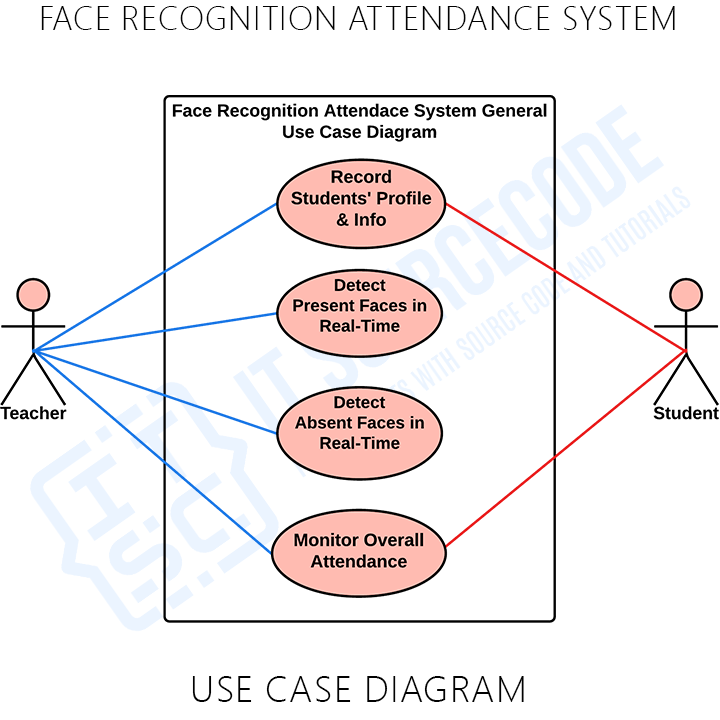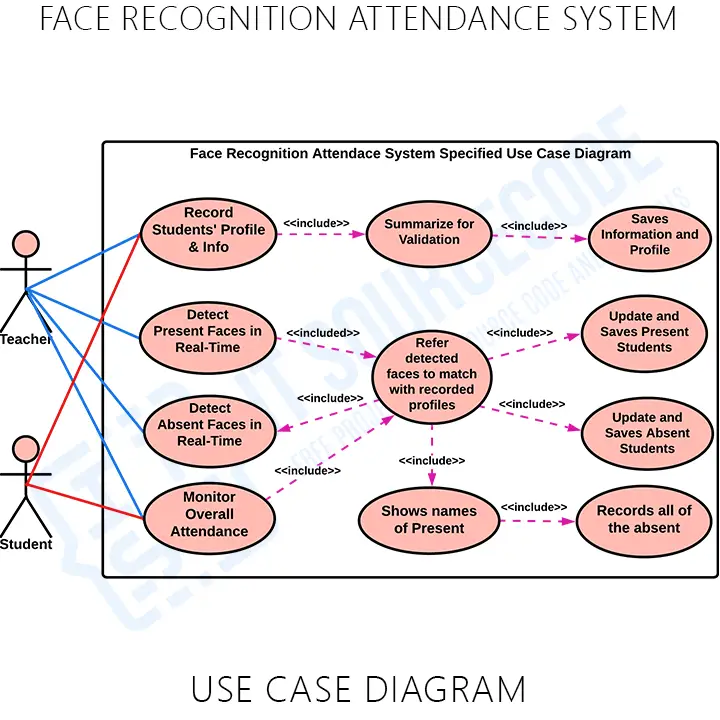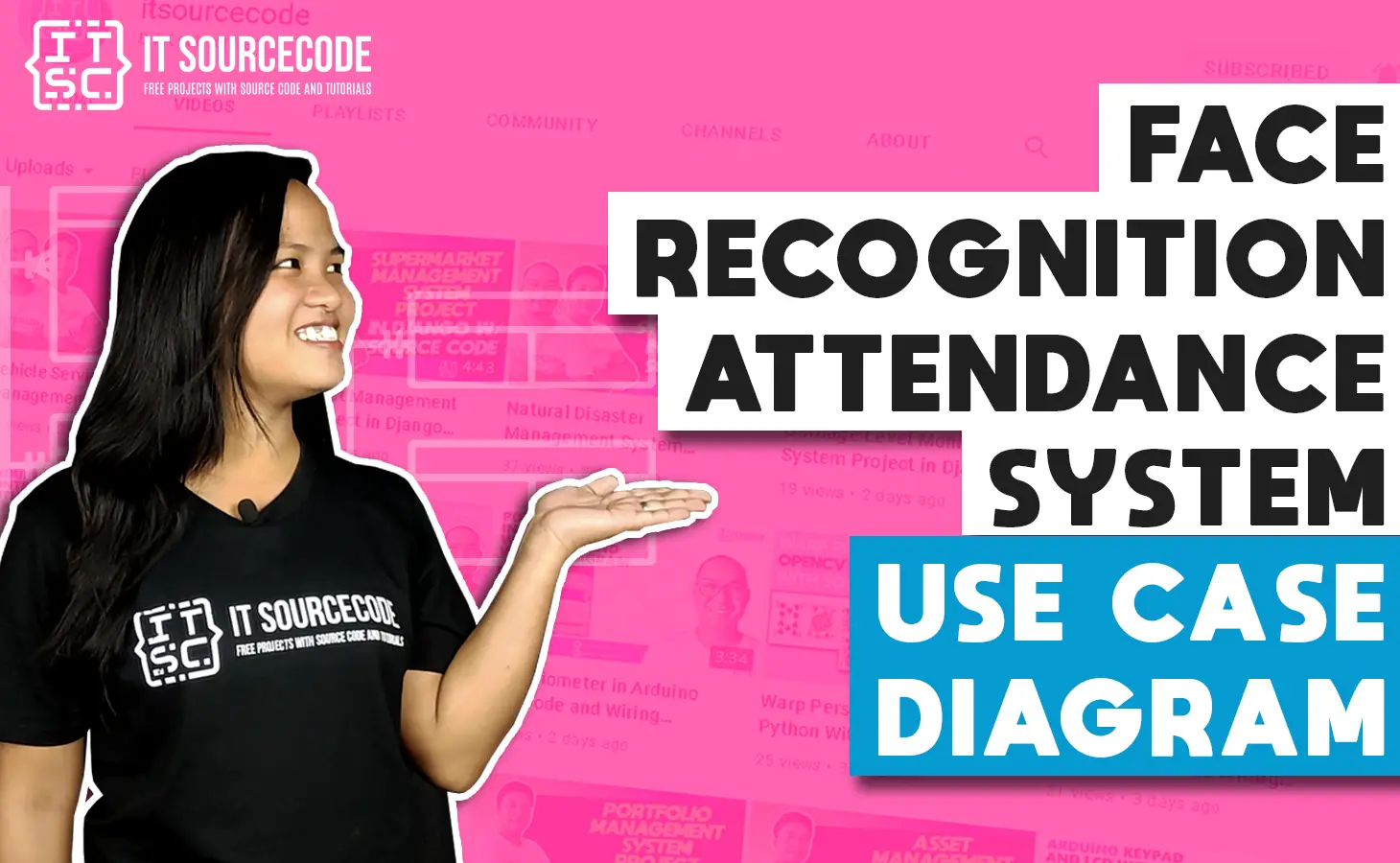The UML use case diagram for face recognition system is used to show the processes involved when users invoke the software. It depicts the structure of the system behavior.
Additionally, the diagram consists of processes (use cases) and users or “actors”. It uses defined symbols to describe the overall flow of the system.
Project Overview
| Name: | Face Recognition Attendance System |
| UML Diagram: | Use Case Diagram |
| Users: | Establishment’s Admin, Employee/Authorized Personnel, Students or Employees. |
| Tools Used: | Diagram tools that provide activity diagram symbols. |
| Developer: | ITSourceCode.com |
What is a Face Recognition Attendance System?
The face recognition system is used to help companies in checking attendance through face detection. It is done using biometric technology, scanning a face in an image or video.
The facial recognition system stores face identification in the database. It will use artificial intelligence and facial recognition technology to recognize faces. This recognition works when faces from the database and real-time match.
Moreover, the system applies a recognition algorithm to check attendance. It lessens the admin’s workload in monitoring the employees or students. Thus, the system secures attendance records and generates timely reports.
What is a Use Case Diagram?
The use case diagram shows the sample behavior of the face recognition system. It includes the project functions using use cases, actors, and their connections.
Moreover, the diagram assists you to define and organize project needs. This also provides a clear picture of the user and system relationships. Therefore, this diagram depicts the complex functions of a system including how the user reacts to it.
Importance of UML Use Case Diagram
Helping the developers and businesses with system management is one of the importance of the UML use case diagram. It includes the procedures from the viewpoint of users.
Furthermore, the diagram is the analysis method used to identify, clarify, and manage project needs. This diagram works best with other UML Diagrams for Face Recognition System. Other UML diagrams include activity, class, sequence, deployment, and component diagrams.
Face Recognition Attendance System Use Case Diagram
The designed face recognition system use case diagram has two main illustrations. These illustrations describe the system’s general processes and specific processes using include and extend.
Additionally, the general use case diagram highlights the main processes of the system. The specific use case diagram, on the other hand, points out the sub-processes from the main process. It adds specific details from the general information.
General Use Case Diagram
The general use case diagram for face recognition attendance system shows the general functions that the system could do. It is based on the transactions needed in checking attendance.

As seen in the illustration, the face recognition system has 4 main processes. It includes the recording of student profiles, real-time detection of attendance, and monitoring overall attendance.
The mentioned processes were based on the face recognition system functions. However, you can modify this according to your project needs and requirements.
Use Case Diagram using Include and Extend
The use case diagram using include and extend is used to elaborate the proceeding diagrams. The terms include and extend in the use case diagram are known as indicators.
This illustration has a more detailed figure of use case diagram using include and extend. This is to help you specify the included activities in completing a process or task.

The broken arrows are indications that the following diagrams connected to them are parts of a process. They could either be one of the indications which were the include or extend.
The “include” indication means that the following use case was compulsory to finish the task and the “extend” indication is otherwise.
You can add more to this illustration and it is up to you how will you create your diagram. But make sure to have precise information and consider the included use cases.
Additional Knowledge
The objective of a use case diagram is to show the relationship between the actors with the use case. This enables programmers to capture the main functionalities of a system.
Through the diagrams, there are the use cases involved to define the core functions of a system. These processes were connected to produce a certain output.
Downloadable Pdf File
You may download this provided Pdf file as a reference for your project. This can also be modified or utilized directly in your project. To modify the diagram, make sure to be precise with your information.
How to draw a Use Case Diagram?
Time needed: 2 minutes
Here’s the complete guide on how to draw a use case diagram for face recognition attendance system.
- Step 1: Familiarize Use Case Diagram Symbols
For beginners in the field of designing the diagram, you need first to familiarize the symbols to be used.
- Step 2: Determine the targeted users
The next step is to determine your targeted users. They will be the ones to use your project.
You may ask the users about the typical activities done in face recognition. - Step 3: Analyze the use cases included
The gathered information from the users needs to be evaluated to know the general use cases.
From the general use cases, you will see the sub-cases that are included. But, only the useful processes and circumstances related to the face recognition system. - Step 4: Plot the Use Case Diagram
To plot the diagram you will need the users, use cases, container (scope), and their indicators (association). You will base the flow of use cases on the evaluated information from the users.
You need to place first the users involved.
Then place the figured use cases included in doing the process.
After that, you will trace the association of the use cases to know the interactions between the user/s and the system.
Finally, put the container in the plotted diagram to separate the objects’ (users and system) scope.
Conclusion:
One of the methods that contribute to the face recognition system development is the UML use case diagram. It helps developers know the possible inputs that the project should process and perform.
Furthermore, you will find out the needed processes and connect them to the other UML Diagrams. The diagram is also applicable in modeling the software’s use cases (processes). It also captures the system’s flow from one process to the next.

